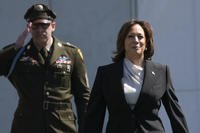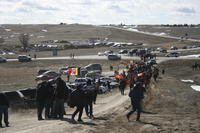WASHINGTON, D.C. -- At the corner of Vermont Avenue and H Street, District of Columbia National Guard soldiers silently stood behind riot shields, blocking protesters' access to Lafayette Square.
The tightly packed crowd was still angry about police driving demonstrators out of the square near the White House on Monday, using flash bang grenades and pepper projectiles.
Read Next: Lightning Strike Injures 2 National Guard Members in DC
"It is our duty to fight for our freedom!" demonstrators chanted. "We have nothing to lose but our chains!"
The D.C. Guard members wore body armor and helmets, with riot face shields, but carried no weapons. They had U.S. Army rank patches, but no name tapes.
Some 1,600 members of the D.C. National Guard and thousands of Guard members from other states spent long nights in the District this week, some of them posted near their own neighborhoods as protests over the May 25 death of George Floyd in Minneapolis flooded the streets. Early in the week, protesters broke the windows of businesses and tagged historic monuments with graffiti in angry demonstrations.
But as days passed, the protests assumed a more peaceful rhythm. On Wednesday, video even circulated of demonstrators swaying together and holding up cellphones as they listened to a fellow protester sing "Lean on Me."

Military.com spent Wednesday night in the city, speaking with troops about the uncommon mission -- one a senior defense official earlier that day described as the least desired of all in the Guard portfolio.
"We can help enforce the laws, and we do that. We enforce the laws of cities and states underneath the accountable, elected civilian officials where we live, because we work for them," the official told reporters at the Pentagon. "That's how and why we do it, but it's not a good, fun mission. Nobody likes breaking up a fight."
If fighting was minimal Wednesday, the tension was nonetheless palpable between demonstrators and the uniformed troops who stood in rows not far from the White House.
A young black woman held a megaphone inches from Guard members' faces.
"You have no badge numbers; you have no names," she demanded. "Who am I supposed to report if something happens to me? If something happens to me, who am I supposed to report?"
Many protesters simply stood in the 90-degree heat, holding signs painted with "Black Lives Matter" and "Enough is Enough."
But others pushed right up to the unarmed Guard members, taunting them as if to provoke armed police standing behind them.
"Why are you in riot gear?!" one protester shouted. "There is no riot here!"
In other parts of the city, the tone was more tranquil.
A 38-year-old tech sergeant from the D.C. Air Guard, described the scene at the Lincoln Memorial the night before, where demonstrations were largely calm.
A few Guard members and police stood on the steps as people walked by with signs, while others rested on the steps, he said.
"It was nonviolent; it was peaceful," said the aircraft maintainer from the 113th Aircraft Maintenance Squadron, who agreed to be interviewed as long as his name was not used. "They got their point across without doing anything to hurt anybody, in a tasteful manner."
Before joining the Guard a little over two years ago, he served on active duty in the Air Force from 2001 to 2016, deploying to Iraq in 2005 and to Afghanistan in 2015.
He said he has never experienced anything like the demonstrations touched off by the death of Floyd, an unarmed black man who died recently in the custody of Minneapolis police. He also expressed his sympathy with the protesters' cause, and the challenge of having to don the uniform and stand opposite them.
"It's a little conflicting, because I kind of agree with why they are protesting. But at the same time, I have a job to do and I have been called to protect the D.C. area," he said.
He said he feels a connection to the protesters "because I am African American, I am black, and these things happen to us all the time."
"People may think that they are not happening, but they do," he said.
He said there doesn't seem to be an acceptable way to protest police brutality and racial injustice, whether it's athletes taking a knee at sporting events or protesters demonstrating near the White House.
"You take a knee, you do other things and that's bad -- you're are disgracing, you are doing bad stuff. And then you try to protest, and that's bad," he said."Everything is bad, so I mean -- at what point is enough is enough?"
So far, approximately 41,500 Guard troops have been activated in 32 states and D.C. to support the civil unrest response, Guard officials said Friday.
At the request of President Donald Trump, about 4,000 Guard members from Florida, Indiana, Maryland, Missouri, Mississippi, New Jersey, Ohio, South Carolina, Tennessee and Utah have deployed to the District to support the D.C. Guard's 1,200 members activated in the city.
Earlier in the week, about 1,600 active-duty soldiers from Fort Bragg, North Carolina, and Fort Drum, New York, deployed to the region to be available if needed. But the 82nd Airborne Division's 2nd Battalion, 504th Parachute Infantry Regiment, has returned to Bragg, and soldiers from the 91st Military Police Battalion have been given a verbal order to return to Drum, Army Secretary Ryan McCarthy told reporters Friday.
"Really, the decision to bring the active-duty forces on Monday was largely due to the fact that we did not have enough people here," he said. "Sunday was an incredibly challenging night for us. The Lincoln monument was defaced, we had five soldiers hit in the head with a brick ... and inside Lafayette Square, we definitely lost control to the point where they were right up on the north [White House] fence."
McCarthy said he was pleased that there had been four peaceful days in a row as of June 5. He was confident, he said, that the Guard has the forces it needs to support police in the city.
"We are in a very good posture because we have been able to generate enough personnel from the National Guard standpoint to support the operations at present," he said.
While some are military police, many other Guard members assisting police and law enforcement have job specialties ranging from munitions systems specialists to supply sergeants.
A female sergeant from Delta Company, 1st Battalion, 224th Aviation Regiment, talked to Military.com during a break from roadblock duty near the White House.
Since arriving Saturday, the 31-year-old supply specialist with the D.C. Guard had done everything from delivering food and water to Guard members to establishing vehicle roadblocks at key locations in the city.
During her nine years with the Guard, which began in Tennessee, she deployed to Afghanistan twice, in 2015 and 2018.
Most of the interactions she has had with demonstrators in D.C. have been nonhostile, she said.
"I have had a little of everything ... from people appreciating that we are here, just standing around making sure that everyone is OK, to people that are not very happy that we are here, basically yelling at us and telling us we don't belong here -- that this is their city, not ours," she said.
It's a difficult mission, she said, because protesters and people in general are "confused on what our purpose is here.
"I think people don't understand," she said. "We had a guy today accusing us of having weapons and coming out here gun-toting, and I'm like, 'Sir we are not armed.'"

Many Guard members deployed in cities around the country carry personal weapons, but the D.C. guard made the decision for troops to remain unarmed to avoid being perceived as a hostile force, D.C. Guard Command Sgt. Maj. Michael Brooks said in a statement to Military.com.
"We do not want to be confused with an offense force in our community," Brooks said. "Whether it's a service member holding a shield or a civilian protesting, we are neighbors, friends and family members, and we only want to protect the safety of our citizens as they peacefully exercise their right to protest."
The supply sergeant said she has seen many acts of kindness in D.C. since Saturday.
"We had a family over here today -- it was a little boy and his mom and a couple of friends -- and they stood there for four hours handing out bottles of water to us, police officers, whoever they came in contact with," she said.
At one point, a white man, who appeared to be in his early 40s, jeered at her and three other soldiers while crossing the street about 20 feet away.
"Hey how's it going?" he shouts. "You like this?! You like hurting people?! Huh?! F---ers!"
Guard members ignored the comments, and the man continued walking.
"I haven't had anything that has been too close for comfort," the supply sergeant said. "Most of it has been, they just get close enough where they can yell at you and make sure that they are making a scene."
D.C. is known for being a vibrant city, filled with museums and historic sites that attract tourists from around the world.
But the recent violence during protests, on top of the novel coronavirus pandemic, has transformed the streets around the Capitol and the White House into an eerily quiet space that echoes with the angry chants of demonstrators in the evening hours.
Each morning, crews work to cover more glass storefronts with plywood to protect them if demonstrations turn violent. Fresh graffiti such as "Black Lives Matter" and "We are Unarmed" adorns road barriers and some historic buildings.
During one protest Wednesday evening, a black man screamed so loudly at his fellow protesters that his voice became hoarse.
"This ain't about George Floyd!" he screamed. "This is for all our ancestors. ... Don't let this movement die!"
Close to 10 p.m. Wednesday evening, a 25-year-old first lieutenant with the D.C. Guard told Military.com that he couldn't believe how much the city had changed since he visited it with his parents after graduating high school in Michigan.
"They took me out here and took a picture in front of the White House," he said. "I mean, standing in front of it now with lines of protesters and barricades up and everything, it's just such a different perspective for me."
Before becoming the education services officer for the D.C. Guard's 260th Regimental Training Institute, he taught middle school in D.C. for two years through Teach for America, a nonprofit organization designed to confront education inequity in America.
Since Saturday, he has commanded soldiers standing in shield walls, bearing the brunt of protesters' anger.
"It's a lot; there is a lot of emotion out there," he said, the strain of the past few days audible in his voice. "A lot of people out there -- you can feel the frustration. It's quite a sight to take in."
Protesters have often vented their anger at him and his soldiers, who are there to keep the situation safe for everyone, he said.
"I think the most challenging aspect of this detail is understanding the scope of the frustration and making sure that we are keeping everyone safe and that they understand that we are there for their safety," he said. "There is definitely a lot of emotion on our side, as well; it's not an easy undertaking for us."
-- Matthew Cox can be reached at matthew.cox@military.com.
Related: Top Pentagon Leaders Summoned to Testify on Military's Response to Protests












